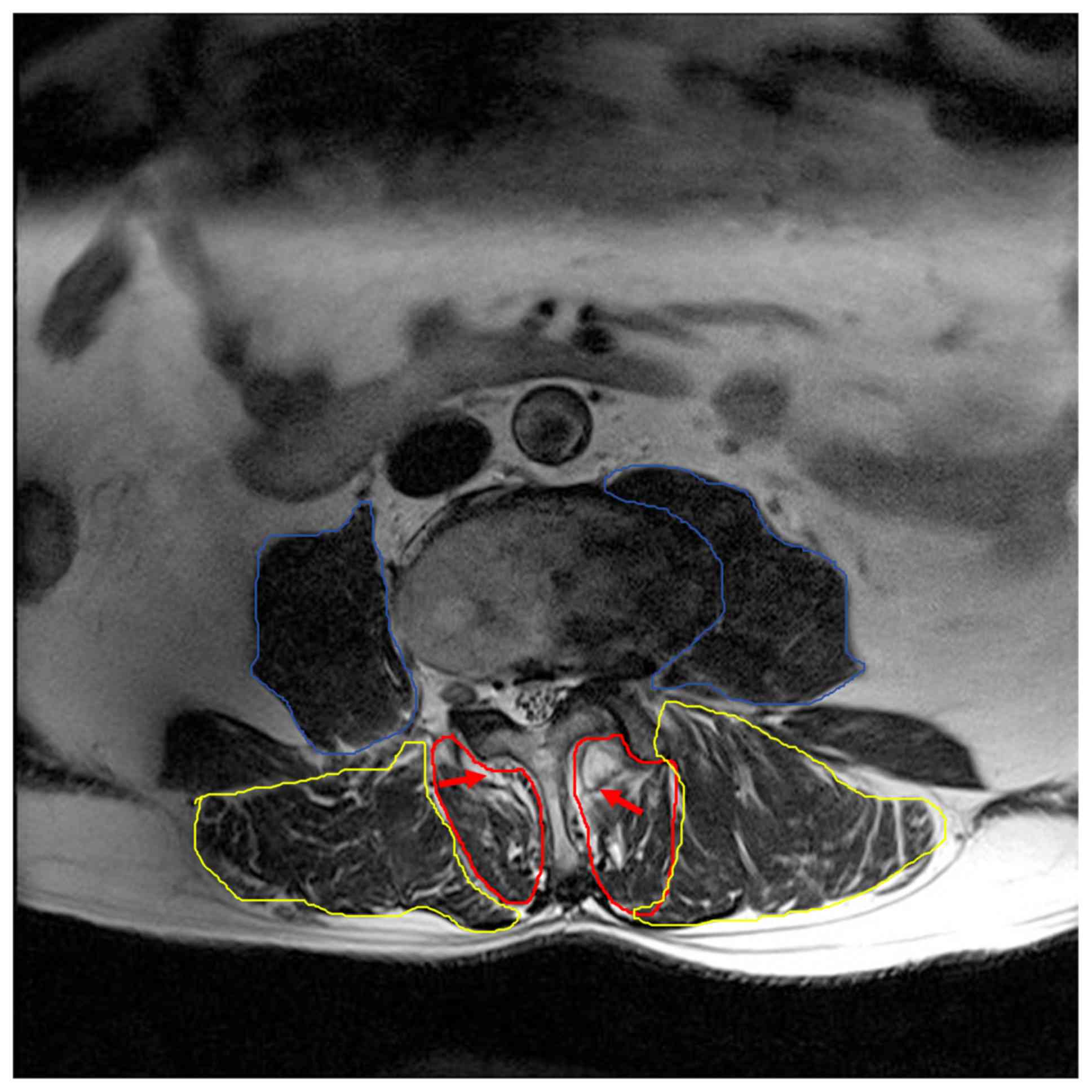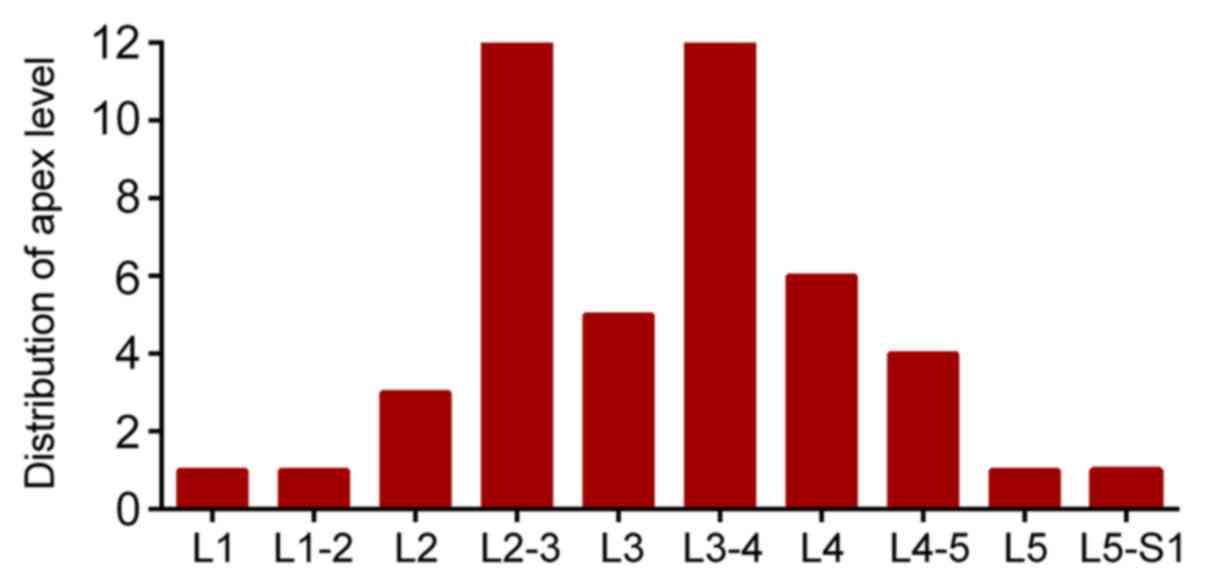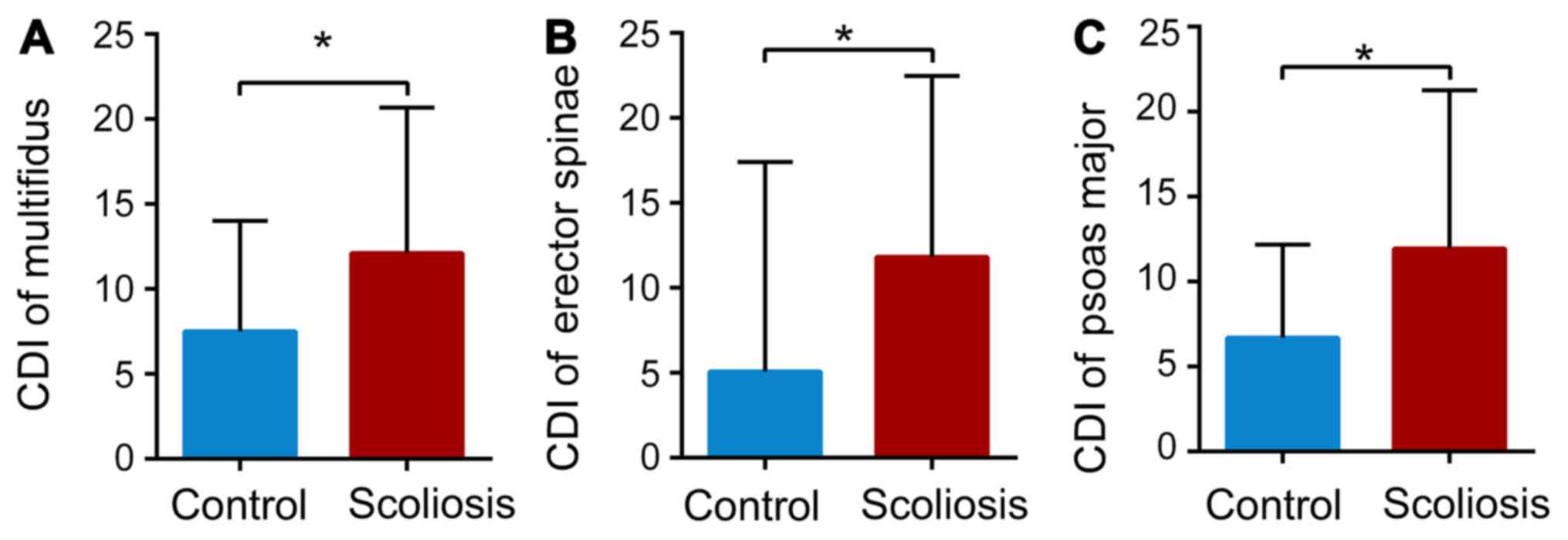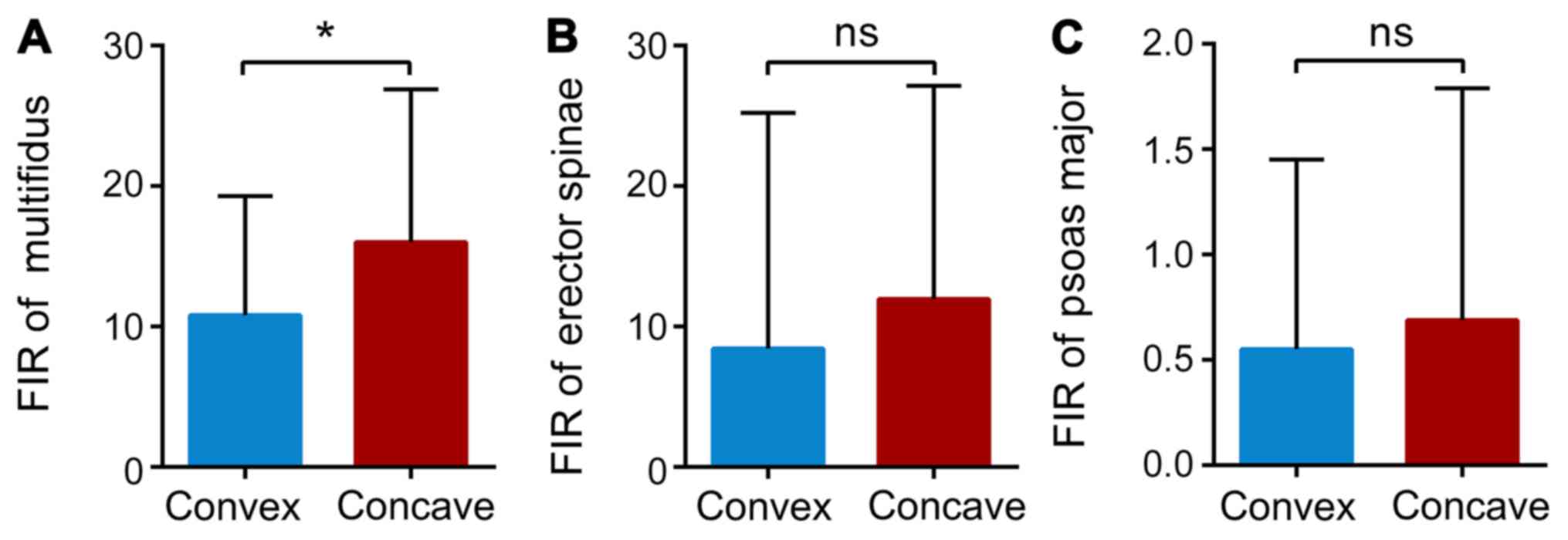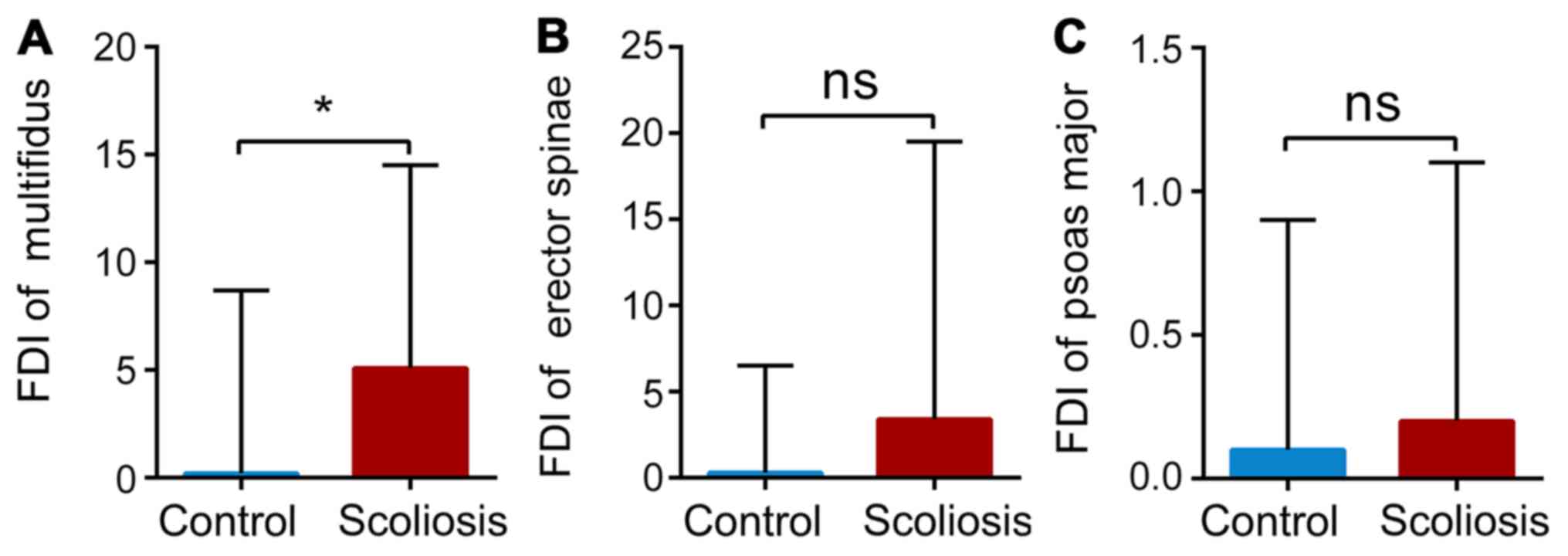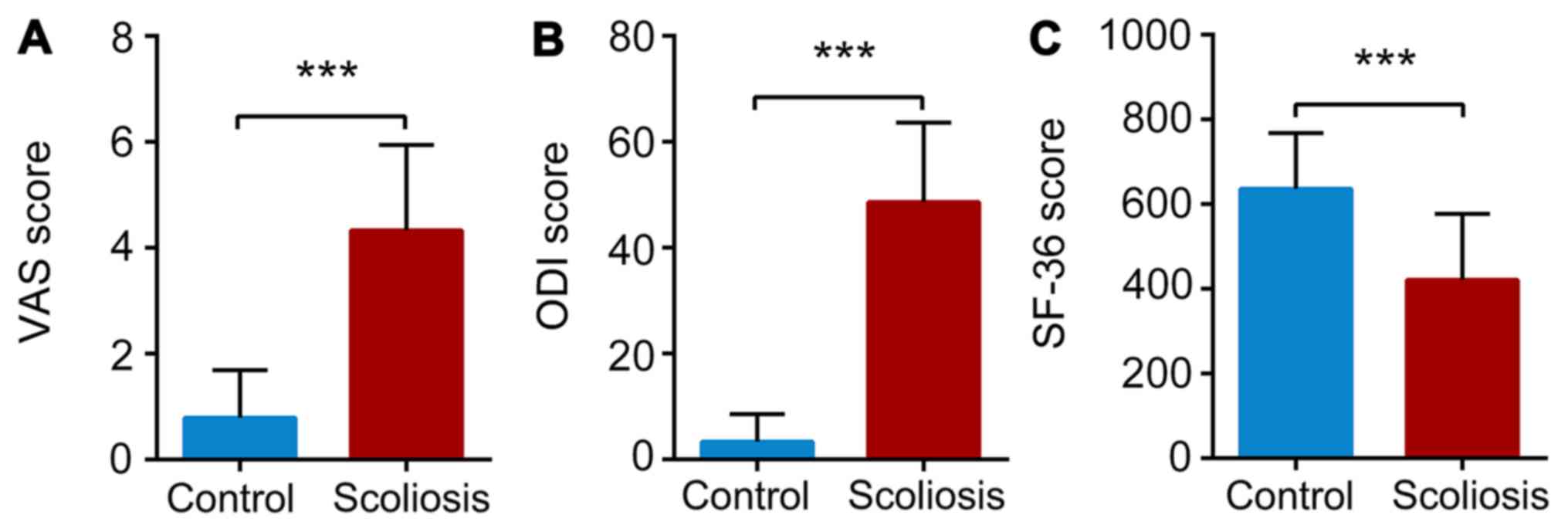|
1
|
Kim H, Lee CK, Yeom JS, et al: Asymmetry
of the cross-sectional area of paravertebral and psoas muscle in
patients with degenerative scoliosis. Eur Spine J. 22:1332–1338.
2013.PubMed/NCBI View Article : Google Scholar
|
|
2
|
Buell TJ, Chen CJ, Nguyen JH, Christiansen
PA, Murthy SG, Buchholz AL, Yen CP, Shaffrey ME, Shaffrey CI and
Smith JS: Surgical correction of severe adult lumbar scoliosis
(major curves ≥75˚): Retrospective analysis with minimum 2-year
follow-up. J Neurosurg Spine. 31:1–14. 2019.PubMed/NCBI View Article : Google Scholar
|
|
3
|
Voirin-Hertz M, Carvajal Alegria G,
Garrigues F, et al: Associations of lumbar scoliosis with
presentation of suspected early axial spondyloarthritis. Semin
Arthritis Rheum. 50:48–53. 2020.PubMed/NCBI View Article : Google Scholar
|
|
4
|
Diebo BG, Shah NV, Boachie-Adjei O, Zhu F,
Rothenfluh DA, Paulino CB, Schwab FJ and Lafage V: Adult spinal
deformity. Lancet. 394:160–172. 2019.PubMed/NCBI View Article : Google Scholar
|
|
5
|
Yaltırık K, Güdü BO, Işık Y, Altunok Ç,
Tipi U and Atalay B: Volumetric Muscle Measurements Indicate
Significant Muscle Degeneration in Single-Level Disc Herniation
Patients. World Neurosurg. 116:e500–e504. 2018.PubMed/NCBI View Article : Google Scholar
|
|
6
|
Doktor K, Jensen TS, Christensen HW,
Fredberg U, Kindt M, Boyle E and Hartvigsen J: Degenerative
findings in lumbar spine MRI: An inter-rater reliability study
involving three raters. Chiropr Man Therap. 28(8)2020.PubMed/NCBI View Article : Google Scholar
|
|
7
|
Haddas R, Xu M, Lieberman I and Yang J:
Finite Element Based-Analysis for Pre and Post Lumbar Fusion of
Adult Degenerative Scoliosis Patients. Spine Deform. 7:543–552.
2019.
|
|
8
|
Zheng J, Yang Y, Cheng B and Cook D:
Exploring the pathological role of intervertebral disc and facet
joint in the development of degenerative scoliosis by biomechanical
methods. Clin Biomech (Bristol, Avon). 70:83–88. 2019.PubMed/NCBI View Article : Google Scholar
|
|
9
|
Liu Y, Pan A, Hai Y, Li W, Yin L and Guo
R: Asymmetric biomechanical characteristics of the paravertebral
muscle in adolescent idiopathic scoliosis. Clin Biomech (Bristol,
Avon). 65:81–86. 2019.PubMed/NCBI View Article : Google Scholar
|
|
10
|
Banno T, Arima H, Hasegawa T, Yamato Y,
Togawa D, Yoshida G, Yasuda T, Oe S, Mihara Y, Ushirozako H, et al:
The Effect of Paravertebral Muscle on the Maintenance of Upright
Posture in Patients With Adult Spinal Deformity. Spine Deform.
7:125–131. 2019.PubMed/NCBI View Article : Google Scholar
|
|
11
|
Dallaway A, Kite C, Griffen C, Duncan M,
Tallis J, Renshaw D and Hattersley J: Age-related degeneration of
the lumbar paravertebral muscles: Systematic review and three-level
meta-regression. Exp Gerontol. 133(110856)2020.PubMed/NCBI View Article : Google Scholar
|
|
12
|
Crawford RJ, Volken T, Ni Mhuiris Á, Bow
CC, Elliott JM, Hoggarth MA and Samartzis D: Geography of Lumbar
Paravertebral Muscle Fatty Infiltration: The Influence of
Demographics, Low Back Pain, and Disability. Spine. 44:1294–1302.
2019.PubMed/NCBI View Article : Google Scholar
|
|
13
|
Ortega-Porcayo LA, Leal-López A,
Soriano-López ME, Gutiérrez-Partida CF, Ramírez-Barrios LR,
Soriano-Solis S, Rodríguez-García M, Soriano-Solis HA and
Soriano-Sánchez JA: Assessment of Paraspinal Muscle Atrophy
Percentage after Minimally Invasive Transforaminal Lumbar Interbody
Fusion and Unilateral Instrumentation Using a Novel Contralateral
Intact Muscle-Controlled Model. Asian Spine J. 12:256–262.
2018.PubMed/NCBI View Article : Google Scholar
|
|
14
|
Kjaer P, Bendix T, Sorensen JS, Korsholm L
and Leboeuf-Yde C: Are MRI-defined fat infiltrations in the
multifidus muscles associated with low back pain? BMC Med.
5(2)2007.PubMed/NCBI View Article : Google Scholar
|
|
15
|
Kader DF, Wardlaw D and Smith FW:
Correlation between the MRI changes in the lumbar multifidus
muscles and leg pain. Clin Radiol. 55:145–149. 2000.PubMed/NCBI View Article : Google Scholar
|
|
16
|
Hides JA, Stokes MJ, Saide M, Jull GA and
Cooper DH: Evidence of lumbar multifidus muscle wasting ipsilateral
to symptoms in patients with acute/subacute low back pain. Spine.
19:165–172. 1994.PubMed/NCBI View Article : Google Scholar
|
|
17
|
Ranson CA, Burnett AF, Kerslake R, Batt ME
and O'Sullivan PB: An investigation into the use of MR imaging to
determine the functional cross sectional area of lumbar paraspinal
muscles. Eur Spine J. 15:764–773. 2006.PubMed/NCBI View Article : Google Scholar
|
|
18
|
Woodfield JC, Pettigrew RA, Plank LD,
Landmann M and van Rij AM: Accuracy of the surgeons' clinical
prediction of perioperative complications using a visual analog
scale. World J Surg. 31:1912–1920. 2007.PubMed/NCBI View Article : Google Scholar
|
|
19
|
Middendorp M, Vogl TJ, Kollias K,
Kafchitsas K, Khan MF and Maataoui A: Association between
intervertebral disc degeneration and the Oswestry Disability Index.
J Back Musculoskeletal Rehabil. 30:819–823. 2017.PubMed/NCBI View Article : Google Scholar
|
|
20
|
Mmopelwa T, Ayhan S, Yuksel S, Nabiyev V,
Niyazi A, Pellise F, Alanay A, Sanchez Perez Grueso FJ, Kleinstuck
F, Obeid I, et al: European Spine Study Group (ESSG): Analysis of
factors affecting baseline SF-36 Mental Component Summary in Adult
Spinal Deformity and its impact on surgical outcomes. Acta Orthop
Traumatol Turc. 52:179–184. 2018.PubMed/NCBI View Article : Google Scholar
|
|
21
|
Xie D, Zhang J, Ding W, et al: Abnormal
change of paravertebral muscle in adult degenerative scoliosis and
its association with bony structural parameters. Eur Spine J.
28:1626–1637. 2019.PubMed/NCBI View Article : Google Scholar
|
|
22
|
Schwab F, Dubey A, Gamez L, El Fegoun AB,
Hwang K, Pagala M and Farcy JP: Adult scoliosis: Prevalence, SF-36,
and nutritional parameters in an elderly volunteer population.
Spine. 30:1082–1085. 2005.PubMed/NCBI View Article : Google Scholar
|
|
23
|
Campbell PG and Nunley PD: The Challenge
of the Lumbosacral Fractional Curve in the Setting of Adult
Degenerative Scoliosis. Neurosurg Clin N Am. 29:467–474.
2018.PubMed/NCBI View Article : Google Scholar
|
|
24
|
Simon MJK, Halm HFH and Quante M:
Perioperative complications after surgical treatment in
degenerative adult de novo scoliosis. BMC Musculoskelet Disord.
19(10)2018.PubMed/NCBI View Article : Google Scholar
|
|
25
|
Sun XY, Kong C, Lu SB, Wang W, Cheng YZ,
Sun SY, Guo MC and Ding JZ: The Parallelogram Effect of
Degenerative Structures Around the Apical Vertebra in Patients with
Adult Degenerative Scoliosis: The Influence of Asymmetric
Degeneration and Diagonal Degeneration on the Severity of
Deformity. Med Sci Monit. 25:3435–3445. 2019.PubMed/NCBI View Article : Google Scholar
|
|
26
|
Rustenburg CME, Kingma I, Holewijn RM,
Faraj SSA, van der Veen A, Bisschop A, de Kleuver M and Emanuel KS:
Biomechanical properties in motion of lumbar spines with
degenerative scoliosis. J Biomech: Nov 9, 2019 (Epub ahead of
print).
|
|
27
|
Chon J, Kim HS, Lee JH, Yoo SD, Yun DH,
Kim DH, Lee SA, Han YJ, Lee HS, Han YR, et al: Asymmetric Atrophy
of Paraspinal Muscles in Patients With Chronic Unilateral Lumbar
Radiculopathy. Ann Rehabil Med. 41:801–807. 2017.PubMed/NCBI View Article : Google Scholar
|
|
28
|
Kang CH, Shin MJ, Kim SM, Lee SH and Lee
CS: MRI of paraspinal muscles in lumbar degenerative kyphosis
patients and control patients with chronic low back pain. Clin
Radiol. 62:479–486. 2007.PubMed/NCBI View Article : Google Scholar
|
|
29
|
Reza MM, Subramaniyam N, Sim CM, Ge X,
Sathiakumar D, McFarlane C, Sharma M and Kambadur R: Irisin is a
pro-myogenic factor that induces skeletal muscle hypertrophy and
rescues denervation-induced atrophy. Nat Commun.
8(1104)2017.PubMed/NCBI View Article : Google Scholar
|
|
30
|
Hiyama A, Katoh H, Sakai D, Tanaka M, Sato
M and Watanabe M: The correlation analysis between sagittal
alignment and cross-sectional area of paraspinal muscle in patients
with lumbar spinal stenosis and degenerative spondylolisthesis. BMC
Musculoskelet Disord. 20(352)2019.PubMed/NCBI View Article : Google Scholar
|
|
31
|
Hyun SJ, Bae CW, Lee SH and Rhim SC: Fatty
Degeneration of the Paraspinal Muscle in Patients With Degenerative
Lumbar Kyphosis: A New Evaluation Method of Quantitative Digital
Analysis Using MRI and CT Scan. Clin Spine Surg. 29:441–447.
2016.PubMed/NCBI View Article : Google Scholar
|
|
32
|
Kalichman L, Carmeli E and Been E: The
Association between Imaging Parameters of the Paraspinal Muscles,
Spinal Degeneration, and Low Back Pain. BioMed Res Int.
2017(2562957)2017.PubMed/NCBI View Article : Google Scholar
|
|
33
|
Fortin M, Gibbons LE, Videman T and Battié
MC: Do variations in paraspinal muscle morphology and composition
predict low back pain in men? Scand J Med Sci Sports. 25:880–887.
2015.PubMed/NCBI View Article : Google Scholar
|
|
34
|
Zoabli G, Mathieu PA and Aubin CE: Back
muscles biometry in adolescent idiopathic scoliosis. Spine J.
7:338–344. 2007.PubMed/NCBI View Article : Google Scholar
|
|
35
|
Burakiewicz J, Sinclair CDJ, Fischer D,
Walter GA, Kan HE and Hollingsworth KG: Quantifying fat replacement
of muscle by quantitative MRI in muscular dystrophy. J Neurol.
264:2053–2067. 2017.PubMed/NCBI View Article : Google Scholar
|
|
36
|
Johnson BL, Schroeder ME, Wolfson T, Gamst
AC, Hamilton G, Shiehmorteza M, Loomba R, Schwimmer JB, Reeder S,
Middleton MS, et al: Effect of flip angle on the accuracy and
repeatability of hepatic proton density fat fraction estimation by
complex data-based, T1-independent, T2*-corrected, spectrum-modeled
MRI. J Magn Reson Imaging. 39:440–447. 2014.PubMed/NCBI View Article : Google Scholar
|
|
37
|
Goubert D, Oosterwijck JV, Meeus M and
Danneels L: Structural Changes of Lumbar Muscles in Non-specific
Low Back Pain: A Systematic Review. Pain Physician. 19:E985–E1000.
2016.PubMed/NCBI
|
|
38
|
Wong E, Altaf F, Oh LJ and Gray RJ: Adult
Degenerative Lumbar Scoliosis. Orthopedics. 40:e930–e939.
2017.PubMed/NCBI View Article : Google Scholar
|
|
39
|
Honkanen T, Mäntysaari M, Leino T, Avela
J, Kerttula L, Haapamäki V and Kyröläinen H: Cross-sectional area
of the paraspinal muscles and its association with muscle strength
among fighter pilots: A 5-year follow-up. BMC Musculoskelet Disord.
20(170)2019.PubMed/NCBI View Article : Google Scholar
|
|
40
|
Xu M, Yang J, Lieberman I and Haddas R:
Finite element method-based study for effect of adult degenerative
scoliosis on the spinal vibration characteristics. Comput Biol Med.
84:53–58. 2017.PubMed/NCBI View Article : Google Scholar
|
|
41
|
Wilke HJ, Wolf S, Claes LE, Arand M and
Wiesend A: Stability increase of the lumbar spine with different
muscle groups. A biomechanical in vitro study. Spine. 20:192–198.
1995.PubMed/NCBI View Article : Google Scholar
|
|
42
|
Fortin M and Macedo LG: Multifidus and
paraspinal muscle group cross-sectional areas of patients with low
back pain and control patients: A systematic review with a focus on
blinding. Phys Ther. 93:873–888. 2013.PubMed/NCBI View Article : Google Scholar
|
|
43
|
Le Cara EC, Marcus RL, Dempsey AR, Hoffman
MD and Hebert JJ: Morphology versus function: The relationship
between lumbar multifidus intramuscular adipose tissue and muscle
function among patients with low back pain. Arch Phys Med Rehabil.
95:1846–1852. 2014.PubMed/NCBI View Article : Google Scholar
|
|
44
|
Hebert JJ, Le Cara EC, Koppenhaver SL,
Hoffman MD, Marcus RL, Dempsey AR and Albert WJ: Predictors of
clinical success with stabilization exercise are associated with
lower levels of lumbar multifidus intramuscular adipose tissue in
patients with low back pain. Disabil Rehabil. 42:679–684.
2020.PubMed/NCBI View Article : Google Scholar
|
|
45
|
Glassman SD, Bridwell KH, Shaffrey CI,
Edwards CC II, Lurie JD, Baldus CR and Carreon LY: Health-Related
Quality of Life Scores Underestimate the Impact of Major
Complications in Lumbar Degenerative Scoliosis Surgery. Spine
Deform. 6:67–71. 2018.PubMed/NCBI View Article : Google Scholar
|
|
46
|
Kim JB, Park SW, Lee YS, Nam TK, Park YS
and Kim YB: The Effects of Spinopelvic Parameters and Paraspinal
Muscle Degeneration on S1 Screw Loosening. J Korean Neurosurg Soc.
58:357–362. 2015.PubMed/NCBI View Article : Google Scholar
|
|
47
|
Li H, Wang H, Zhu Y, Ding W and Wang Q:
Incidence and risk factors of posterior cage migration following
decompression and instrumented fusion for degenerative lumbar
disorders. Medicine (Baltimore). 96(e7804)2017.PubMed/NCBI View Article : Google Scholar
|
|
48
|
Hyun SJ, Kim YJ and Rhim SC: Patients with
proximal junctional kyphosis after stopping at thoracolumbar
junction have lower muscularity, fatty degeneration at the
thoracolumbar area. Spine J. 16:1095–1101. 2016.PubMed/NCBI View Article : Google Scholar
|















